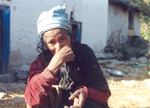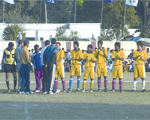
Nepal is the threshold of a documentaryfilm revolution.In 2003 Bheda Ko Oon Jasto ran to a ful house at jai Nepal Cinema. Earlier this month, Sa Karnali Through Dolpo opemed at Kumari Cinema. Documentaries screen regularly on local tv channels, and Nepali documentaries open to enthusiastic crowds all over the world from Amsterdam to Ithaca.
When the Himalayan Film Festival opened in 1994, few would have thought that 12 years later, like Nepal's FM radio success, there would be a boom in documentary filmmaking here too.
New technology, political changes, freer media, and exposure to international films have made amateur and professional documentary filmmakers out of many Nepalis. In the past documentaries were considered 'funded' projects, designed to fulfil NGOs' development propaganda, but now local documentaries are made on subjects ranging from the conflict, cultural phenomena, individual portraits, and entertainment.
"Documentaries did become a tool for development propaganda, but the interest of development organisations in films also brought in new technology," says Mohan Mainali, director of The Living of Jogimara. "Liberal media and digital technology gave the necessary impetus to an already brewing documentary revolution."
 The audience for these films is unique in Nepal-the same crowd that enjoys mainstream, commercial films also watches documentary and independent films. The films have local content that is relevant or amusingly offbeat, and generally manage to transcend language barriers.
The audience for these films is unique in Nepal-the same crowd that enjoys mainstream, commercial films also watches documentary and independent films. The films have local content that is relevant or amusingly offbeat, and generally manage to transcend language barriers.
Young viewers in particular are enthusiastic attendees at Kathmandu film festivals. With increased exposure to documentaries, viewers are better able to understand the grammar of the genre, and now watch more critically and demand better films.
 The rise of the Nepali documentary is interesting to track. When Ankhijhyal, a fortnightly television magazine made by Nepal Forum of Environment Journalists started airing on Nepal Television in the 1990s, it was the only mainstream outlet for issue-based and in-depth stories.
The rise of the Nepali documentary is interesting to track. When Ankhijhyal, a fortnightly television magazine made by Nepal Forum of Environment Journalists started airing on Nepal Television in the 1990s, it was the only mainstream outlet for issue-based and in-depth stories.
When the Maoists started their 'People's War,' few Nepalis in the urban areas or abroad knew what was going on because news coverage was limited to printed media and sporadic images on tv. Dhurba Basnet's 2001 The Killing Terraces brought the graphic images of war closer to home. Then came a number of war films like Schools in the Crossfire, The Living of Jogimara, and Six Stories (all also available in Nepali).
 Parallel to these, numerous cultural documentaries, travelogues, climbing films, and films with social messages were released to sold out shows at festivals and in theatres, and sparked off discussions about the issues they addressed in them and about filmmaking in general.
Parallel to these, numerous cultural documentaries, travelogues, climbing films, and films with social messages were released to sold out shows at festivals and in theatres, and sparked off discussions about the issues they addressed in them and about filmmaking in general.
The best known of these are Kesang Tseten's On the Road with the Red God: Machhendranath and We Homes Chaps, Pranay Limbu's History for Winners, Ramyata Limbu and Sapana Sakya's Daughters of Everest, Alex Gabbay and Subina Shrestha's Kathmandu: Untold Stories, Dinesh Deokota's A Rough Cut on the Life and Times of Lachuman Magar Kiran Krishna Shrestha's Bheda Ko Oon Jasto, and more recently Dil Bhusan Pathak's Newsroom Bahira (Outside Newsroom).
 "Festivals here, and mountain or Himalayan film festivals abroad are getting a lot more films about Nepal and Nepali subjects, made by Nepalis. This just goes to show that more people here are aware of the scope of films," says Ramyata Limbu, who is also director of Kathmandu International Mountain Film Festival (KIMFF).
"Festivals here, and mountain or Himalayan film festivals abroad are getting a lot more films about Nepal and Nepali subjects, made by Nepalis. This just goes to show that more people here are aware of the scope of films," says Ramyata Limbu, who is also director of Kathmandu International Mountain Film Festival (KIMFF).
"In 2000, at the first KIMFF, there were hardly one or two entries from Nepal, but this year we've received over a dozen Nepali entries."
 The increase in numbers is exciting, but documentary filmmaking here is still young and full of challenges. "We have a long way to go in terms of quality," adds Limbu.
The increase in numbers is exciting, but documentary filmmaking here is still young and full of challenges. "We have a long way to go in terms of quality," adds Limbu.
Subina Shrestha, writer of Kathmandu: Untold Stories, says we lag behind in terms of conceptual creativity, adding, "A good film also has to be flawless, but we are yet to master that." The cost of making a documentary has dropped dramatically with digital technology, but it still costs to make quality films. Funding is hard to come by, and often filmmakers don't even know how to tap into existing sources.
 Kathmandu Film Society's Rajesh Gongaju argues that it's about more than just getting funding. "We lack the support base. It's not just about funding, it is about marketing and selling your films," he says.
Kathmandu Film Society's Rajesh Gongaju argues that it's about more than just getting funding. "We lack the support base. It's not just about funding, it is about marketing and selling your films," he says.
On the creative side, most filmmakers agree that exposure to the process of documentary filmmaking is essential. "This is a form of storytelling. Just having a script is not enough-you need time, knowledge of the craft, and expertise to make it good," says Limbu.
 Nepali documentaries so far generally fall into two extreme categories, war films and cultural films. But with the new openness, access to areas previously restricted to filmmakers, and a recharged economy, we can expect the space between films like History for Winners and The Killing Terraces to slowly be filled with stories and images we didn't even know existed, told in innovative ways.
Nepali documentaries so far generally fall into two extreme categories, war films and cultural films. But with the new openness, access to areas previously restricted to filmmakers, and a recharged economy, we can expect the space between films like History for Winners and The Killing Terraces to slowly be filled with stories and images we didn't even know existed, told in innovative ways.


